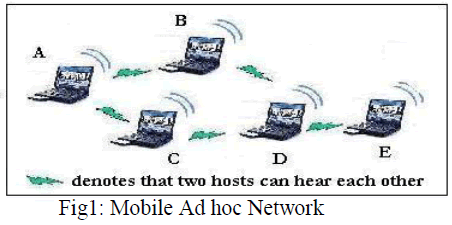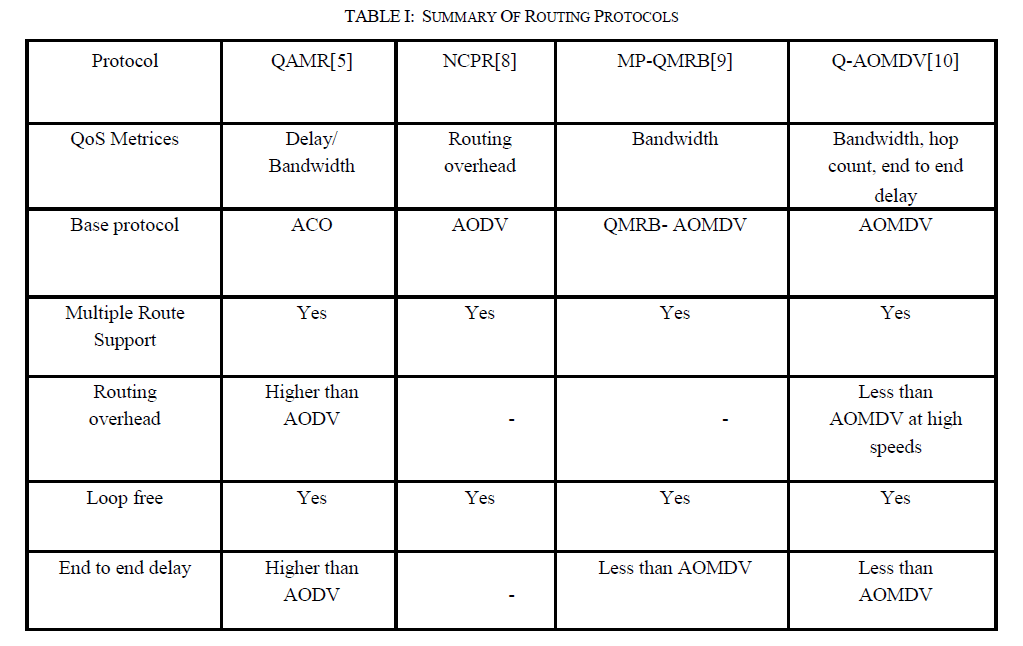ISSN ONLINE(2278-8875) PRINT (2320-3765)
ISSN ONLINE(2278-8875) PRINT (2320-3765)
Roopali Garg1, Guneet Kaur2
|
| Related article at Pubmed, Scholar Google |
Visit for more related articles at International Journal of Advanced Research in Electrical, Electronics and Instrumentation Engineering
Mobile Ad-hoc Networks (MANET) are infrastructure less wireless network in which nodes communicate through radio waves. Routing in MANET is a tough aspect because of its dynamic topology. To deliver the data to the destination is not the only requirement. It should reach the destination fulfilling the quality of service (QoS) requirements. To provide QoS is challenging in MANET because of the dynamic nature of nodes. This paper presents an overview of multipath QoS routing protocols.
Keywords |
| Mobile Ad-hoc Networks (MANET), Quality of service (QoS), QAMR (Quality of Service enabled ant colony based multipath routing), NCPR (neighbour coverage- based probabilistic rebroadcast), MP-QMRB (multipath QoS mobile routing backbones protocol) |
INTRODUCTION |
| Mobile Ad-hoc networks (MANET) are a collection of wireless nodes which do not have any infrastructure unlike cellular networks which are infra-structured (i.e. base-stations are present). MANET consists of nodes (mobiles or laptops) that can act both as routers or hosts. The nodes communicate through radio waves. Range of each node is limited. If a receiver does not lie in senders range then the intermediate nodes act as routers. Routing refers to sending the data from source to destination by first finding a route and then maintaining a route fulfilling QoS requirements. Many routing protocols have been proposed like AODV (Ad-hoc on demand distance vector) [1], DSR (dynamic source routing)[2]. But these routing protocols do not provide QoS. |
| QoS is defined as the service requirements which need to be satisfied while sending the data from source to destination. QoS metrics could be defined in terms of one or a set of parameters: time, bandwidth requirement, probability of packet loss the variation in latency (jitter), Delay, routing overhead, Scalability, There are several QoS constraints: time, load balancing, latency, packet loss, delay, jitter[3]. The parameters linked with each link in the network are classified into: additive constraints and concave constraints [4]. Example delay is an additive constraint. The delay of the whole path from source to destination is calculated by summing up the delay of each link. Bandwidth is a concave constraint which is calculated by minimum bandwidth for a link i.e. each link should fulfil the criterion of minimum bandwidth. |
 |
| A number of QoS routing protocols have been proposed. These protocols can be classified into proactive (table driven) and reactive (on-demand) protocols. In table driven protocols all the nodes maintain their tables and these tables are updated from time to time. In reactive protocols the route is established only when data is to be send. In this paper, several QoS routing protocols have been reviewed which provide QoS using different approaches. |
| In [5] authors proposed the protocol QAMR. It is based on ant colony optimization (ACO). It is used to solve the problem of bandwidth allocation in MANET. FANTs (forward ants) and BANTs (backward ants) are the ant like agents which are used to measure parameters like next hop availability (NHA), delay and bandwidth. Path preference probability is calculated using these parameters and the path with highest path preference probability is selected to transmit data. |
| For the route discovery, FANTs and BANTs are used. FANTs are broadcasted to the neighboring nodes having NHA>NHAthr. FANTs have the address of all the nodes through which it passes. When FANT reaches the destination it waits for time Tw for receiving all the FANTs then all the paths that satisfy Dc>Dt, Bc>Bt, Hc>Ht are found. Then the path preference probabilities for all the paths are calculated using formula: |
| P(i)= (dgbghg)i/ Σj€pi(dgbghg)j. |
| dgbghg are the percentage of goodness of QoS parameters: delay, bandwidth, hop count respectively. |
| Then BANTs are generated to all the paths that satisfy QoS requirements. The destination appends its own address to the path field. The BANT is unicast to source node. The BANT with highest pheromone concentration is selected and data transmission takes place. |
| The performance of QAMR was compared with AODV [6] and ARMAN [7] and it was found that QAMR performed better for the metrics packet delivery ratio, QoS path success ratio, routing overhead. |
| III. NCPR |
| In Xin Ming Zhang [8] proposed neighbor coverage-based probabilistic rebroadcast for reducing routing overhead in mobile Ad-hoc networks. In NCPR algorithm: |
| (1) Rebroadcast delay is calculated which is used to determine the forwarding order. To calculate the rebroadcast delay the node which receives the RREQ packet calculates the uncovered neighbors. Rebroadcast delay is calculated according to the neighbor list in RREQ packet and its own neighbor list. |
| U(ni)= N(ni)-[N(ni)∩N(s)]-{s} |
| N(ni) and N(s) are the neighbor sets of node I and s respectively. If the bode has more number of common neighbors then the delay is less. |
| (2) Rebroadcast probability is calculated. It is composed of two parts additional coverage ratio and connectivity factor. Additional coverage is the ratio of the number of nodes that are additionally covered by the rebroadcast to the total number of neighbors of node ni. Connectivity factor is the number of neighbors connected with each node. Using additional coverage ratio and connectivity factor the rebroadcast probability is calculated. NCPR generates less rebroadcast traffic than flooding. There is less redundant rebroadcast, which help in increasing packet delivery ratio and decrease end to end delay. The protocol performs good in high density or heavy traffic load. |
IV. MP-QMRB |
| M Ali[9] proposed a multipath QoS mobile routing backbones protocol. It has been proposed to enhance load balancing in MANET. Protocol ensures that the available bandwidth in the network is utilized efficiently by distributing traffic evenly which ensures better load balancing and congestion control. This is motivated by QMRB-AODV. |
| The protocol combines the routing backbone concept of QMRB-AODV with the multipath capability of AOMDV. This protocol uses RREQ and RREP mechanism as in AODV [1] to find the route. The protocol is implemented in two steps: |
| ïÃâ÷ To compute multiple loop free link disjoint paths. ïÃâ¬Ã |
| ïÃâ÷ Establishment of mobile routing backbones. The protocol performs better in dense networks. As compared with QMRB-AODV and AOMDV it has been found that MP-QMRB performs better in terms of end to end delay at higher node speeds. It performs better in terms of throughput, end to end delay, packet delivery ratio and routing overhead. ïÃâ¬Ã |
V. Q-AOMDV |
| Chunxue Wu [10] have proposed Ad-hoc on demand multipath routing which provides QoS support. For route discovery process in Q-AOMDV, RREQ message includes hop-count, time and bandwidth also to select the primary path in all the available paths. RERR message also contain these parameters. |
| For Route Maintenance in Q-AOMDV, when a node is unable to send data to the next node of the route i.e. the link is disconnected. A ROUTE ERROR (RERR) packet is sent to the source which contains the information of the upstream and downstream nodes of the broken link. The source removes every entry in its route table that uses the broken link . If one route fails then an alternative route is chosen. |
| Q-AOMDV provides better results in terms of end to end delay, routing load and packet delivery. |
VI.CONCLUSION |
| In this paper, several multipath routing protocols have been discussed. These protocols use several QoS metrics like bandwidth, delay, routing overhead, hop count. QAMR is an ant colony optimization based protocol. NCPR uses AODV as a base protocol. MP-QMRB uses QMRB-AOMDV as base protocol. Q-AOMDV has AOMDV as the base protocol. Table below shows the comparison of the above routing protocols on the basis of several parameters and features. |
 |
References |
|